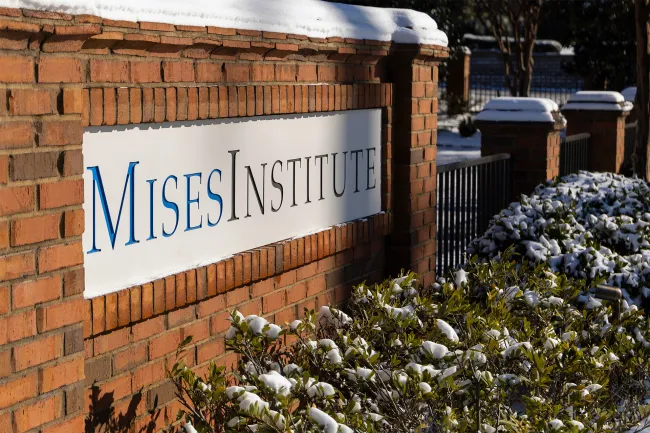[A Balance of Titans by Ivan Eland. (Independent Institute, 2025; 150pp.)]
Ivan Eland has long been a figure of respect among those who favor a less aggressive foreign policy, and he is also outstanding in his ability to come up with bold and original arguments, not only in defense studies but also in constitutional interpretation. These qualities are much in evidence in his new book A Balance of Titans, and in what follows I’ll comment on a few points of interest.
After World War II, the United States engaged in a protracted cold war with the U.S.S.R., but the collapse of the Soviet regime did not lead America to dismantle its bloated defense spending. Instead, it sought and achieved a hegemonic position in the world. e.g., “by expanding the NATO alliance up to Russia’s shrunken borders after the Cold War.” This position is no longer tenable, owing to the rise of military powers like China able to compete with America and the great strain on our economy that the large deficits needed to finance the defense budget impose.
The inability to sustain hegemony compels attention to the question, why should we seek hegemony? It is not in accord with our traditional foreign policy of non-intervention; and if it is urged that an isolationist foreign policy risks threats against us by China and Russia and possibly others, these threats can be contained with much less expense. Europe has ample resources to defend itself against Russian expansion, and Japan against China; moreover, smaller powers who feel threatened by Russia or China can join regional coalitions against them. Russia lacks the resources to pursue an expansionist foreign policy, as its economy is in poor shape and its armed forces have struggled without success to conquer Ukraine. In any case, the abandonment of hegemony would lessen the threat that Russia and China perceive from the United States.
Why not, then, adopt a streamlined budget that enables America to follow a foreign policy of “Independent Internationalism”? Eland shows with immense technical knowledge which cuts in the defense budget would enable us to repel any threats that might in future be directed against us. So long as we maintain a “second-strike” capacity through nuclear submarines that would deter a nuclear power that might threaten us, we can eliminate most of our nuclear weapons. If we do not do so, we may soon have no choice:
In addition to contributing to the yawning annual federal budget deficits and massive national debt, US financial exhaustion—exacerbated by the demographic time bomb of having more retirees drawing public pensions and fewer workers paying into the Social Security system—eventually will likely compel significant cuts in the military budget. Therefore, instead of just taking a meat axe to DoD’s budget, the more modest strategy of Independent Internationalism should be adopted, and military forces, weapons, and budgets should be adjusted downward in a more rational and orderly manner.
Unfortunately, that is easier said than done, because efforts at reform are blocked by what Eland calls the “Military-Industrial-Congressional Complex (MICC).” Weapons systems are sources of jobs in many states, and firms which produce such weapons deliberately spread them out as much as possible so that Congress will vote to keep them in operation, regardless of their redundancy and excessive cost.
Readers of these pages will not be accustomed to praise for Franklin Roosevelt, and Eland is himself no admirer; but he holds that FDR was far less belligerent toward the U.S.S.R. than his successor Harry Truman, who not only bears responsibility for the great war crime of dropping atomic bombs on Hiroshima and Nagasaki, despite the fact that Japan was already endeavoring to surrender, but also for the largely unnecessary Cold War against the Soviets. In this connection, Eland observes:
Truman initiated an expansive American global war on communism to “contain” the movement’s postwar expansion in the world. . . . It eventually succeeded, but that was mainly because the Soviet Union’s clearly dysfunctional economic system eventually collapsed. But containment was not the only option at the time. There was a less expensive way to facilitate this collapse. It would have started with policy makers realizing that communism, contrary to its own ideology, appealed mainly to people in poor countries that, because they were poor, were hardly strategic to US national security. . . [Instead of containment] a cheaper way to induce this effect would have been to allow the communists to take over the economic basket cases of the developing world—such as Korea, Vietnam, Afghanistan, Nicaragua, and Angola—thereby draining Soviet resources by foisting the military, economic, and administrative costs to these countries’ main communist benefactor. Such attempts by the Soviet Union to expand communism in the developing world likely would have hastened that superpower’s inevitable overextension.
It is interesting to contrast this analysis with that of Ludwig von Mises, who concurred with Eland in holding that a centrally planned economy faced inevitable collapse but argued instead that this would induce the Soviets to expand into Europe in an effort to obtain more resources.
My principal criticism of the book is that Eland does not go far enough. He says that,
…prior to World War II, US vital interests, with some exceptions, were confined mainly to the Western Hemisphere (mainly North America and the Caribbean) and the sea approaches to American coasts in the Atlantic and Pacific. This more limited conception of US security interests needs to be reinstated, leaving behind the unclear and inconsistent expansive US policy of being the global policeman.
Why not instead limit US interests to the defense of our own country? Our fortunate geographical position still renders us almost invulnerable to attack. We can thus, with a clear conscience, avoid any additional commitments and say, “America goes not abroad in search of monsters to destroy.”


